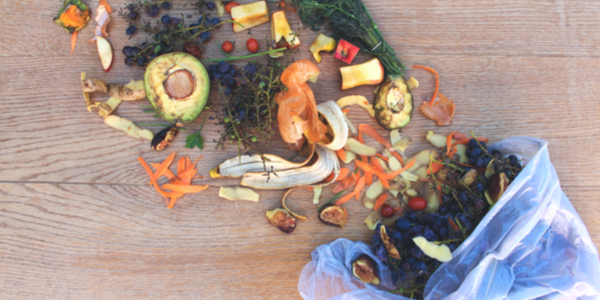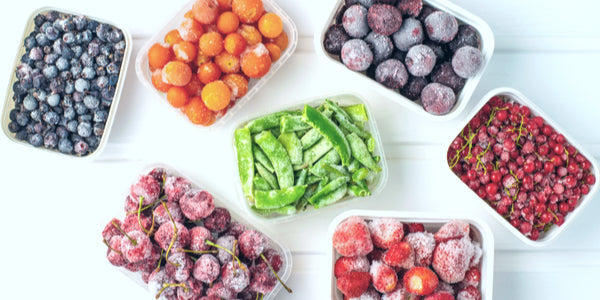
Worried about the "right" way to reduce food waste? Wondering about how to minimize food waste at home?
Instead of getting too caught up in what others say about how to reduce food waste, choose a few of the tips in this article to act on today to make a difference.
Read on for the 15 best ways to reduce food waste, including easy methods for minimizing food loss at home once and for all.
Food waste, also called food loss, is defined as the amount of edible food that is available for consumption but is not reasonably consumed. It is considered an umbrella term that encompasses many of the following potential reasons for food waste, including:
• Pests
• Inadequate climate control
• Cooking loss
• Natural shrinkage
• Moisture
• Banana peels
• Bones from food
• Eggshells
Essentially, food waste refers to any food that could have been saved for another purpose before heading towards the landfill.
Food waste in the United States is (U.S.) estimated at 30 to 40 percent of the food supply, including:
• 31 percent food loss at retail and consumer levels
• 133 billion pounds of food
• $161 billion worth of food
These numbers draw attention to important and impending issues. Food waste affects the environment, sustainability efforts, and contributes to food insecurity in harmful ways.
Food Waste and the Environment
Processing and producing food requires a lot of resources. Even whole foods need to be transported, prepared, and stored.
Beyond that, additional energy is needed to dispose of and discard food properly. When good food goes unused or spoils because of improper storage, these costs factor into the waste as well.
If that wasn’t bad enough, waste that ends up in landfills creates methane gas. This greenhouse gas is potent and increases harmful emissions in the air.
Food Waste and Sustainability
When food is wasted, so are the resources used to produce it. This includes:
• Land
• Water
• Labor
• Energy
• Inputs
Wasting food is not sustainable as a business practice. From farm to table, if food becomes wasted due to damage, spoilage, over-ordering, or for other reasons, patterns of food loss eventually cause liability and loss.
Food Waste, Hunger, and Food Insecurity
Wholesome food can feed families in need, but it often ends up in landfills from the houses of families with excess. Teaching families proper and simple solutions for reducing food waste can create a consistent food supply for those who need it most.
Food waste and food insecurity are problems that consistently affect the population. Fortunately, sustainable practices and employing optimal food recovery strategies creates possible solutions for both.
There isn’t one "right" way to reduce food waste. The best solution is the one that works for individuals, organizations, and businesses so that they can each contribute what they can to reduce food waste.
What Is the Food Waste Hierarchy?
The Food Waste Hierarchy, also known as the Food Recovery Hierarchy, prioritizes actionable prevention for wasted food. In other words, it focuses on different management strategies for food waste.
The hierarchy is shaped like an upside-down triangle, similar in appearance to the food pyramid of the past. Top, wider levels encompass strategies for food waste that many organizations and individuals can participate in.
The Most and Least Preferred Methods of Food Waste
The levels narrow as the hierarchy reaches the bottom and final destination, which is the landfill or incineration. Considered the last resort for disposal, the hierarchy illustrates more preferable options and actions that citizens can take to recover food. The goal is to rescue food for other uses before it becomes waste that is potentially harmful to the environment.
From top to bottom, and in order of most to least preferred, levels of the Food Waste Hierarchy include:
1. Source reduction: reduce the volume of surplus food generated (i.e. being mindful of portion sizes and making choices based on calorie needs)
2. Feed hungry people: donate any excess to food banks, soup kitchens, shelters, etc.
3. Feed animals: convert or divert food scraps for use as animal food
4. Industrial uses: provide waste products for fuel conversion or energy recovery
5. Composting: create nutrient-rich soil from food scraps
6. Landfill/incineration: seen as the least preferred and "last resort" method
How to Determine the Shelf Life of Foods
Many other foods include terms and dates that can help indicate when the quality of food declines. These indicators can be helpful, however, they do not necessarily mean the food item must be disposed of.
Understanding the following terms can be helpful in efforts to extend shelf life and reduce food waste:
• "Use by", "Best by", "Best before" - These terms are typically found on foods such as condiments and dressings and indicate that the products generally do not require refrigeration until after they are opened. In many cases, these foods are safe to eat past the date indicated (assuming proper storage).
• "Sell by" - These terms are used on perishable items, such as fresh produce, meat, dairy products, and seafood. These foods should be used or frozen within days of the indicated date. Foods that are perishable should always be stored at the proper, safe temperature.
Here are the best tips for reducing food waste that any individual can take action on today:
1. Food Waste To Compost
Compost is a material that is added to the soil to help plants grow. With some basic know-how of composting at home, it is possible to save food scraps, such as the following, for a nutrient-rich second life:
• Fruit scraps
• Coffee grounds and filters
• Eggshells
• Teabags
• Nutshells
• Peanut leaves
2. Food Waste For Gardening
Whether for stress relief, alone time, or experiencing the outdoors, the fruits of gardening extend to the environment. Community gardens and individual gardens can contribute to the efforts of reducing food waste by employing sustainable methods of growing food.
Find out what can be composted or recycled for the purposes of growing food. This practice can routinely save money and reduce trips to the grocery store. It’s also a powerful and personal way to decrease food waste in the community and beyond.
3. Safely Learn to Process Food at Home
Cut the costs of production on the environment by learning to can or dehydrate foods at home.
4. Make the Most of Fruits & Vegetables
According to a recent report, fruits and vegetables make up one of the highest categories of food waste. Instead of contributing to the nearly 40% of fruits, vegetables, and mixed dishes headed to the garbage bin, try these easy tips for making the most of produce:
• Keep peeled or pre-cut fruits and veggies sealed, and store in the fridge
• Understand which foods and unripe fruits can stay fresh outside the fridge
• Freeze overripe leftover fruits and veggies before they expire beyond being edible
• Incorporate ripe fruits or vegetables into blended or cooked dishes
• Remember frozen or canned options can be just as nutritious
5. Know How Long Meal Deliveries Last
Finding out how long meals will last when a meal delivery service is utilized is a great way to reduce food waste. Most services use a freezing method, which extends the shelf-life, for transportation and quality reasons.
6. Plan Meals with On-Hand Ingredients
Treasure hunt in the fridge before sweeping the supermarket aisles. Often, a well-organized pantry, fridge, and freezer contain the base of a healthy meal.
7. Get Creative with Leftovers
Sliced leftover vegetables or meat can easily be incorporated into the following meals:
• Cooked grain (i.e. rice or pasta) dishes
• Tortilla wraps
• Stuffed pitas
• Sandwiches
• Soup
• Bento box lunches
8. Create Ideal Storage Environments
Ideal storage systems produce ideal results. Maximize storage with the following methods:
• Buying freezer-safe containers for easy storage
• Learning how to safely stock a fridge for food safety
• Clean and tidy the fridge
9. Use Apps to Keep Food Appetizing
The FoodKeeper App exists for the sole purpose of maximizing freshness and quality of food items. It works with most devices and is a powerful and useful tool for utilizing food before it becomes waste.
Another great option is the Too Good To Go app, which addresses food waste as a worldwide issue.
10. Treat Pantry Storage Like Inventory
One tip for reducing food waste is to treat the pantry storage like a store manager would. Get rid of the older items first by placing products with closer expiration food dates up at the front.
11. Grow to Love Grocery Lists
Abiding by a grocery shopping list helps to limit the food purchased to a consistent, realistic amount. Beyond saving money and time, it also ends up reducing the amount of food that is wasted.
12. Buy Misfit Foods
Give "ugly" foods some love! It’s what is on the inside that counts, anyway. Many foods are being promoted and sold at reduced cost and repurposed, even though they are considered "imperfect".
No one will be able to tell the difference once the food is sliced up and used in a mason jar meal, fruit salad, or any number of other meals.
13. Eat the Entire Food
While it may be popular to peel produce like cucumbers or potatoes, it can be wasteful. Plus, all the ample fiber from these plant components is lost.
Eating all of the edible portions is a nutrient-rich and mindful choice when it comes to avoiding food waste (win-win).
14. Split a Meal or Take a To-Go Box
Meals eaten out are often excessive in size or come with multiple side options. Save the waste and cut the amount of overconsumption by splitting a meal with companions.
Another option is to split an order in two and save the rest as leftovers.
15. Out of Sight, Out of Mind
This tip is more "what not to do". Storing foods that perish quickly in sneaky places leads to spoilage. Placing quick-spoiling foods in visible places helps to minimize food waste.
Try putting these foods at eye level, at the front of the fridge, or on the counter if that is a suitable option.
Another helpful tip is to refrain from washing produce until immediately before preparing or serving. Produce that is washed but not eaten can lose its protective lining, ripen more quickly than usual, or attract bacteria.
Food waste is an issue of concern, though actionable tips can help people waste less food once and for all. Reduce waste by incorporating principles of the food storage hierarchy and other methods touched upon above.
With more intent and action, food waste can be kept to a minimum and lead to major improvements on many levels.
References:
Eating Right and Reduce Food Waste. Eat Right. Published 2021. https://www.eatrightpro.org/-/media/feature/eatright/campaign/nnm2021/tip_sheets/eating-right-and-reduce-food-waste-2021_english_final.pdf?la=en&hash=E24ECD1C491BE2C76E73C3DF16E49F354B9A6EBD.
Food Recovery Hierarchy. United States Environmental Protection Agency. Published December 31, 2020. https://www.epa.gov/sustainable-management-food/food-recovery-hierarchy.
Food Waste FAQs. U.S. Department of Agriculture. https://www.usda.gov/foodwaste/faqs.







